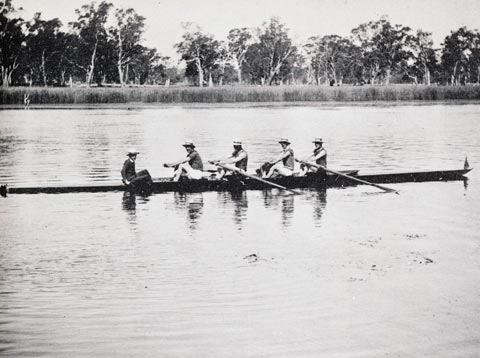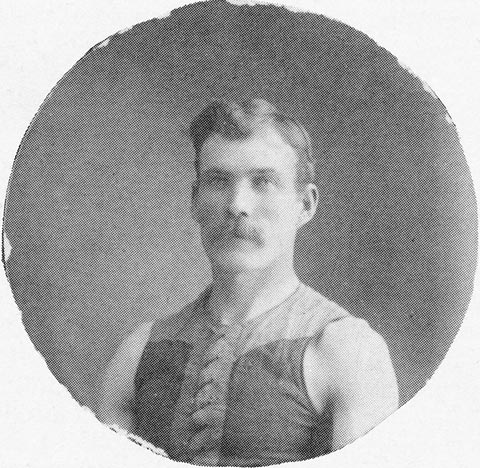A Centenary of Rowing Regattas— Murray Rowing Association
Table of Contents
Introduction- A Hectic Birth
- Early Years on the Lake
- Maturity and Its Problems
- Early Years of Amateur Status
- 1911 Jubilee Regatta
- The Lost Years and Thereafter
- An Explanation
Appendices
- Grand Challenge Races
- 1873 Programme
- Regatta Day by Keith Cammeron
- Grand Challenge Fours Winners
- Presidents
- Conclusion
Photo galleries
4. Early Years of Amateur Status

Well Known Rutheglen Lake Crew - The four Jackson brothers, second generation of the famous rowing family
Rutherglen-Lake purchased Cobram's fleet of outriggers when that Club became defunct, and the Regatta course was surveyed again for a straight mile race (either in 1924 or 1925). This change-over was reflected in the Grand Challenge Race. In 1923 the main race was for "Grand Challenge Four (gigs)," but by 1926 the title of this race had become the "Senior Challenge Four". Thus by the late 1920's the Challenge Fours Race was not considered to be very important as there was a Senior Fours race also on the programme.
Ultimately the Senior Fours displaced the Challenge Race which disappeared after 1930, to end duplication. Prior to the 1920's, outriggers may have been allowed to enter the Challenge Race but none did because they could not compete against the sharp turn of a gig at the peg where the inside bank of oars simply backed water while the other side pulled to spin the gig around suddenly. The report of the last Challenge Race in 1930 is found only at the end of the Regatta report in the "Rutherglen Sun" where the finalists are given as 1, Nagambie; 2 Albert Park; 3 Banks and 4 Wahgunyah, thus demonstrating that the race by now must have included outriggers as Melbourne Clubs are well represented in the finals.
This change-over to outriggers at last encouraged Eight-Oared races. The first was in 1928, but the race nearly had to be removed from the programme because two Melbourne boats (from Banks and Mercantile) which were entered for the event, were swamped at Nagambie in a strong wind and washed onto rocks. Mr. A. Jackson, President of Rutherglen Lake Club offered to repair the boats if they were sent up for the M.R.A. Regatta. This offer was accepted, and he worked day and night to have them ready in time. The first Eight-Oared race took place as planned, thus adding impetus to the change to outriggers and popularsing this Regatta more among Melbourne Clubs. This increasing interest of Melbourne Clubs can be directly attributed to the adoption of outriggers by local Clubs, in 1923 only three local Clubs, took part in the Regatta, whereas by 1926 there were three Melbourne Clubs as well as Nagambie competing.
However, to return to 1892 when the M.R.A, still clung to gigs and the last vestiges of professionalism, trophies continued to be valuable for a few years (in 1892 first prizes generally were valued at £12 and the Challenge Race trophy was valued at £40 with a trophy for second place worth £12/10/-). In order to pay for this, an entry fee was charged for boats in each event (as was usual in previous professional Regattas, the fee was 5% of the value of the prize entered for), and spectators were charged admission - Adults, 1/-; children free, horses and riders 1/-, vehicles and drivers 2/6 and passengers full rate.

Lou Jackson
A well known oarsman, who became a well-known sculler. Later was President of the Murray Rowing Association
Amateur status had one immediate effect in that Melbourne crews became interested in the Regatta. Two Melbourne crews attended the first amateur Regatta in 1892. However the new amateur status must have worried the Regatta Committee and it was decided to employ three mounted police at one shilling per hour per man to supervise the Regatta crowd.
Although this Regatta was under the control of the Victorian Amateur body, some of the older rowers and spectators found the amateur rules hard to comply with. At the old professional gatherings it was quite in order to ram your opponent at the turning point of the course or use other various and devious methods to lead at the turn. Rule 8, as quoted in the 1873 Programme (Appendix 2) merely forbade the use of hands during the confusion of turning. Boats and oars have many unusual uses as old professional rowers had discovered. Even in the early years of the Regatta, interference was a problem because the "Murray Gazette" on March 17th, 1863, complained about the "shameful fouls" in the handicap race at the Regatta of that year. In 1879 there is a detailed report of such an instance. The peg turn was only surveyed during the year 1891 and before that the turn was made around a small island. Needless to say, when out of the eyes of the judges and most spectators, many underhand tactics were resorted to. In the year mentioned, one boat asserted that the crew of another boat had tried to push a man out of their boat with an oar. The accused crew retaliated with the protest that their opponents had tried to unship their rudder to put them out of the race. Even during the last Regatta before assuming amateur rules, a fight had developed while rounding the island. The Rutherglen crew led until the turn when the Corowa boat ran full tilt into them and the "Lady of the Lake" went under with the whole of their bow smashed to pieces. Both crews at least stopped but the Rutherglen crew requested that the race continue so the Lake boat passed both the others and won easily. The Rutherglen crew were rescued by pleasure craft and put ashore. This incident gave rise to a little unpleasantness but beyond a little blood spilt, no harm resulted. At such tactics, the amateurs were justifiably horrified. For this reason the more respectable peg turn was surveyed for the 1892 Regatta.
